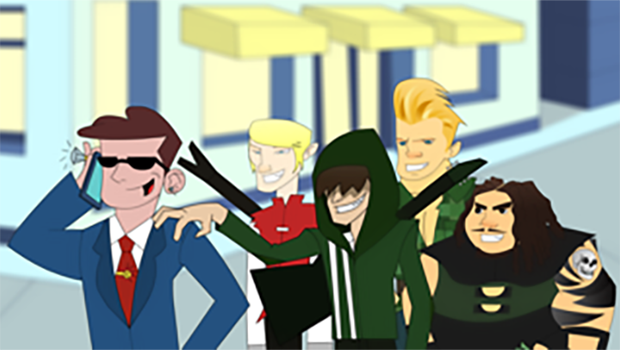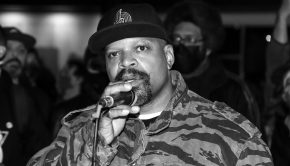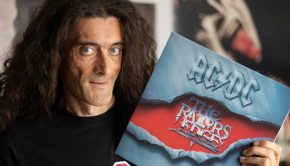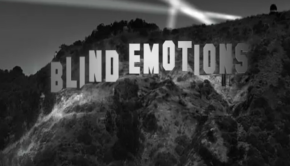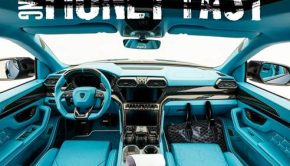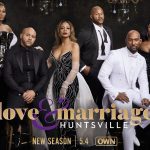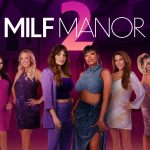THE STOLEN LYRIC: An Animated Rock Movie Musical Experience
“The Stolen Lyric” (@TheStolenLyric) is a modern masterpiece created with music and lyric snippets from over 500 songs. The animated movie is an extremely well-produced visual metaphor for the protests and life disruptions we experience daily. Presented on a Rock based music bed, “Robin Hood” and his band “The Merry,” successfully illuminate the anger, pain, and passion of a country whose citizens were trod on in this last political fiasco.
Amazingly, “The Stolen Lyric” was produced pre-election and could wear the tag of being somewhat prophetic from my point of view. It’s a piece that applies across cultural boundaries since many of us share concerns on the hot-button topics addressed but it’s so damn FUN to watch as well!
As a music lover, I have to #salute the crew that researched and cut the 500-plus segments that constitute the dialogue of the film. It took an incredible knowledge base of music and lyrics to paint the vivid pictures of “The Stolen Lyric.”
How much work went into this?
Number of song clips in “The Stolen Lyric”: 555
Number of artists in “The Stolen Lyric”: 129
Number of unique songs in “The Stolen Lyric”: 478
Average amount “stolen” per song: 12 seconds
Average amount “stolen” per artist: 46 seconds
Overall Rating: 5/5 It’s a full course meal…could be classed as edutainment for real! For the aware folks, it’s more than just a funny film it’s a political commentary for a country that has now instituted immigration checkpoints in some major cities.
Check out the official line on “The Stolen Lyric.”
THE STOLEN LYRIC, a cleverly offbeat edgy experimental animated retelling of Robin Hood set in the rock music world (Robin Hood and his band “ The Merry”) is on your screening radar. The themes expressed in THE STOLEN LYRIC capture the anti-corporate elite anger expressed by Bernie Sanders supporters on the left and Trump supporters on the right.
An animated anti-corporate rock movie musical like no other, THE STOLEN LYRIC updates the medieval ballads of Robin Hood mashup-style, by transforming an epic 555 stolen song fragments from 129 iconic artists into movie dialogue. Forget stealing from the rich to feed the poor: charismatic front man Rob and his rock band “The Merry” take from the corporate fat cats holding culture hostage and give the power back to the people in a rotten tale of brotherhood, betrayal, greed, lust, and general mayhem.
A fearless tale that draws from the past to pave the way for a musical revolution, THE STOLEN LYRIC shows that when it comes to the greed and corruption of the rich and powerful, the song remains the same.
This truly one-of-a-kind hybrid of an arty avant-garde protest film and pop culture fun combines the counterculture attitude of a 70’s rock opera with the sensibility of an Internet mashup video to address issues that are close to the hearts of young people today such as the social impacts of mega-corporate consolidation as well as income inequality and similar to the issues raised by Bernie Sanders in his youth-centric campaign.
THE STOLEN LYRIC is currently available on YouTube and Amazon.
A modern-day Robin Hood and his rock band “The Merry” steal from the rich and fight the corporate machine in an ingenious animated rock opera that transforms an epic 555 song fragments from 129 iconic artists into movie dialogue.
Like “The Stolen Lyric”, the medieval stories of Robin Hood were sung as ballads rather than told as stories.
“The Stolen Lyric” uses sung dialogue rather than discrete songs and therefore has more in common with traditional opera than with modern musicals.
The plot and episodic structure of “The Stolen Lyric” closely follow Howard Pyle’s 1883 novel “The Merry Adventures of Robin Hood”.
The Robin Hood characters in “The Stolen Lyric” were designed to look like hybrids of the traditional characters and modern-day rock personalities, with Rob’s look inspired by Alex Turner of the Arctic Monkeys, LJ’s look inspired by Joshua Homme of Queens of the Stone Age, Will Scarlet’s look inspired by David Bowie, Tucker’s look inspired by Jonathan Davis of Korn, and Sheriff’s look inspired by Nick Valensi of The Strokes.
Writer/Director Chase Peter Garrettson is a pseudonymous New York City-based writer. “The Stolen Lyric” is his first film.
Animator Anthony Morris Jr. is a 2013 graduate of the Art Institute of California – Los Angeles specializing in 2D animation. “The Stolen Lyric” was his first job out of college. As an undergraduate, he interned at Paramount and created animations for the Bonnaroo music festival. More recently, he animated for FOX’s Animation Domination High-Def and created animated music videos for both established and up-and-coming artists.
Producers Sigalit and Shai Trichter are a brother/sister production team that combine Sigalit’s background in publishing and finance with Shai’s experience in independent film and commercial production. Shai was previously a creative executive at Paper Street Films, where he worked on Tony Kaye’s “Detachment.” He has also produced commercials and branded content for clients such as amazon.com, Panasonic, AMC, National CineMedia, and AT&T.
SOCIAL MEDIA
FACEBOOK: https://www.facebook.com/TheStolenLyric/
TWITTER: @TheStolenLyric
Bonus
*FILMMAKER THOUGHTS ON THE 2016 ELECTION AND HOW IT FITS INTO THE THEMES OF THE STOLEN LYRIC
Though it was conceived several years ago, THE STOLEN LYRIC anticipated the social trends that have led to the outcome we’ve just seen in the 2016 presidential election.
This is because the main theme of THE STOLEN LYRIC, a modern take on the story of the medieval icon of class warfare Robin Hood that targets mega-corporations as the enemy, is that the consolidation of global corporate power in the hands of the few has insidiously warped our values and destabilized our society, increasing income inequality and resulting in class warfare.
In the 2016 election, we saw that people on both sides, in the form of Bernie supporters on the left and Trump supporters on the right, have realized that the system is rigged against them, and that Washington politicians have essentially become puppets of our mega-corporate rulers. As THE STOLEN LYRIC suggests, mega-corporations have consolidated so much power that they represent a new aristocracy and ordinary citizens resemble powerless medieval peasants in relation to these corporate kingdoms.
Therefore, people on both sides, seeking to turn back before it’s too late and prevent the corporate kings from sending us back to the middle ages, wanted a change candidate who showed an understanding of the problem and a willingness to fight the corporate establishment.
Ultimately, the left put up an establishment candidate and the right put up a true political outsider who ended up winning.
The Trump victory stunned the mainstream media, but what is actually more stunning is the revelation of how out of touch they are, and why. Whereas the power of medieval aristocrats was tied to land ownership, the power of the corporate aristocrats is tied to the ownership of intellectual property, and the royal courts of the corporate hoarders of intellectual property, headquartered in major urban centers such as New York and Los Angeles, revolve around industries like media, finance, law, entertainment, and tech that generate enormous revenue from intellectual property. And, similar to a medieval royal court, these centers of corporate power operate as geographically isolated bubbles that are more concerned with internal hierarchies, intrigue, and power politics than with what’s going on beyond their own walls, forming not only a deep imbalance of power between those who live in these corporate royal courts and those outside of them, but a deep cultural divide as well.
This division prevented the mainstream media from effectively understanding what’s going on in the rest of the country, away from the concentrations of corporate coastal elites.
THE STOLEN LYRIC recognizes and expresses this central role that intellectual property plays in the consolidation of modern corporate power, because it’s made out of millions of dollars worth of “stolen” corporate-owned intellectual property.
The role of intellectual property in creating class conflict and division is even evident in the candidates themselves, with establishment candidate Hillary Clinton as the subject of derision for making money giving corporate speeches (intellectual property) and outsider candidate Donald Trump admired for making his billions building tall buildings (traditional property).
The message of THE STOLEN LYRIC regarding corporate power as an engine of class division and conflict is more important than ever in light of the outcome of this election. The anger and frustration of those disenfranchised by the intellectual property-based kingdoms of the corporate elites can no longer be safely ignored and swept under the rug. And, if the elected outsider fails to deliver on his promises and turns out to be just another pawn of corporate lobbyists and powerful interests, there’s no telling what the reaction of his betrayed supporters might be.
That’s why it’s critically important for all citizens to wake up to the class warfare brewing thanks to our collective surrender to mega-corporate influence and greed and to unite against our common enemy, our true enemy, which is not each other, but the corporations and their lackeys. Corporate-controlled media on both the left and right consistently rely on divisive social issues to split the public and divert attention from the real source of our problems. In the words of the band Kansas, “The difference between us is a part of the game.” THE STOLEN LYRIC, a production completely free of any corporate influence, calls out that true enemy – the real force tearing at the fabric of our society
Tweet
